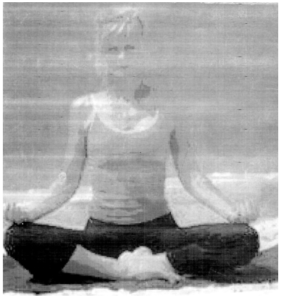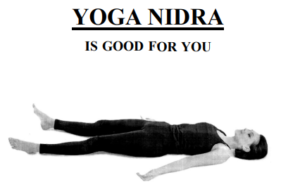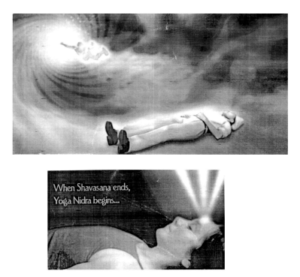Chapter – 5
Yoga
In this post, we have given the Important Questions of Class 11 Physical Education Chapter 5 (Yoga) in English. These Important Questions are useful for the students who are going to appear in class 11 board exams.
| Board | CBSE Board, UP Board, JAC Board, Bihar Board, HBSE Board, UBSE Board, PSEB Board, RBSE Board |
| Textbook | NCERT |
| Class | Class 11 |
| Subject | Physical Education |
| Chapter no. | Chapter 5 |
| Chapter Name | (Yoga) |
| Category | Class 11 Physical Education Important Questions in English |
| Medium | English |
Very Short Answer Type Questions
Q.1 Define Yoga.
Ans. The unification of Jivatma with parmatama is called Yoga.
Q.2 What is Dhayana or concentration?
Ans. The complete concentration of the mind is Dhyana.
Q.3 What are the names of any of their meditative asanas?
Ans. Pdamasana, Sidhasana, Gomukasana.
Q.4. What are the benefits of concentration?
Ans. It creates a positive effect on the brain and calms it.
Q.5 What is the rate of yoga in sports?
Or
Importance of yoga? Describe it.
Ans. Yoga consists of both mentals as well as physical exercise.
- It helps to keep the body fit.
- Relief from any kind of tension
- Improves the heart and jung-functioning capacity.
- It helps in curing and prevention from disease.
- Improves, agility, flexibility, co-ordination, strength etc.
- Improves the co-ordination of body system.
- Improves correct body posture.
Q.6 What is the rate of meditation in sports?
Or
Importance of meditation? Describe it.
Ans.
- Meditation helps to increase concentration.
- It gives relaxation to the body and mind.
- It cures stress and Anxiety.
- It improves the function of nervous system.
- It activates the brain and mind properly.
- It controls anger problem.
Q.7 What is Yog nidra?
Ans. Yog nidra is a effortless relaxation. It is an essential end to any Yoga pose sequence. Yoga posture warm up the body; Yoga nidra ‘cools’ it down.
Q.8 What are the benefits of Yoga Nidra?
Ans.
- Cools down the body after yoga postueres.
- Restoring normal temperature.
- Activates the nervous system to absrob the effects of Yoga asunas.

Short Answer Type Questions
Q.1 How to get ready for a Yoga nidra.
Or
What are the preparations on the part of performer before doing yoga nidra?
Ans. Gettinq ready for Yoga Nidra:
- The stomach has to be empty of light before the practice It is not recommended to practice Yoga asanas or Yoga nidra after a full meal.
- A comfortable clutter free space A yogi’s home is calm, comfortable.
- Some people may feel a little cold after Yoga Nidra, so, it is a good idea to keep a light blanket handy.
Q.2 Explain the procedure, Benefits and precautions during Padmasana.
Ans. Steps of Padmasana (Lotus Pose)
Sit on the floor and stretch your legs, your legs should be straight in front. Hold the right leg in both the hands, fold the legs slowly and place it on your left thigh. Ensure that your feet should touch your navel.
- Padmasana Step 1
Same like earlier fold the left knee, and hold it with both hands and place it on the right thigh close to the other. At this point your both knees should touch the floor and the foot should face upwardly. Your spinal cord should be straight at this point. If you feel some difficulty while sitting in the posture for a long time, you can change the legs and then sit on the same position.
- Padmasana Step 2
Your spinal cord should be erect, your both hands should be together or put the palms facing upside on the knee joints and the thumb must touch your index finger and the other fingers should face the upward. Breathing process should be slowly-slowly and deeply. ( Inhale and Exhale) and focus on your breathing. Do this asana for 2 to 3 minutes in the beginning stage, once you are used to it then increase the time 15 to 30 minutes. Remember one most important thing don’t bend our body or head while doing this Asana.
- Benefits of Padmasana
- Padmasana is the highly preferred asanas by yoga practitioner in the beginning
stage for increase the focus of mind and concentration. It helps in improving
the concentration power and it will calms the brain also. - This Asana helps to preserve vital fluids in the body and prevents abdominal
disease* and female disorders connected with the reproductive organs. - Doing this Asana gives your mind peace, solitude and longovity to the
practitioner. It increases hunger and helps to relax the body. - It can also helps in the stretches the ankle and knees. This Asana is the base for
all asanas and it strengthens the hip and knee joints of the female and can get
painless peaceful mind. - You can reduce the unwanted fat of hip and the thigh. This is the simplest and
easiest asana which can practice by all the age group of men and women they
can get benefits of yogasana.
- Padmasana is the highly preferred asanas by yoga practitioner in the beginning
- Cautions
People who are suffering from ankle injury should not practice this asana. In case you have undergone a recent knee surgery please avoid this asana. If you have sprain in the leg, then our advise is not to do this asana. Don’t perform this if you suffering from severe back pain.
Note:-Do all the Asana in under the Yoga instructor.
Q.3 Explain in detail the steps, benefits and precautions during sakhasana.
Ans.
- Sit on the floor with legs stretched out. Always use a yoga mat or a cushion or a carpet while sitting on the floor.
- Fold the left leg and tug it inside the right thigh. Then fold the right leg and tug in inside the left thigh.
- Keep the hands on the knees. Jnana mudra or Chin mudra can be used if you are using this posture for meditation.
- Sit erect with spine straight.
- Relax your whole body and breathe normally.
- Maintain this position for as long a comfortable.
Benefits To Body Part:
- The Sukhasana is a comfortable, sitting yoga pose that is ideal for meditation. In Sanskrit, Sukh m ease, happiness, peace or relaxation and this pose is aimed at providing all of it. There are many physical, emotional and mental benefits associated with this pose, some of which include –
- Amplifying your state of serenity and tranquility
- Broadens your collarbones and chest
- Calming your brain
- Eliminating stress, anxiety and mental exhaustion
- Improving alignment
- Lengthening your spine
- Opening your hips
- Promoting inner calm
- Reducing fatigue
- Strengthening your back
- Stretching your ankles and knees
Precautions:
- Don’t do sukhasana in inflammation in the knee or hip, spinal disc problems and chronic khee injries.
- Perform this asana under the Guidance and supervision of a certified Yoga guru at least until you master it.
Q.3 Explain in detail the procedure, precautions and benefits of Shashankasana.
Ans.
Procedure:
- First assume vajrasana. Both your asms should be placed on your knees.
- Keep your neck and spinal cord straight.
- Shut your eyes and begin focussing on your breathing and your body.
- Take a deep breath and without allowing the elbow to bend, bring your hands above your shoulders.
- Slowly exhale and reach down to touch the ground while your head and both your hands.
- Let your upper torso relax and remain in this position for a while. The neck should be kept straight between the arms.
- To finish, you shoudl exhale and place your plams on your knees.
Precautions
Avoid practice of this pose if you suffer from vertigo, slipped disc, high blood pressure and heart related problems.
Benefits
- It strengthens the muscules.
- It helps in the extension of the neck, arms and spine.
- Practicing this pose helps improve the circulation of blood to the scalp, face and brain. It gives a rice glow to the face.
- This pose helps in regulating the adrenal glands.
- The hare pose is also peneficial to the reproductive organs.
(5 Mark Questions)
Q.1 Explain the benefits of Yoga nidra in detail.
Ans.

YOGA NIDRA BENEFITS ARE
- It helps in relieving muscular, emotional, and mental tension.
- Yoga nidra relaxes the mind by relieving stress and anxiety.
- It treats insomnia, psychological disorders, and psychosomatic diseases.
- It trains the mind and helps in enhancing memory and increasing learning capacity.
- Yogic sleep also results in increased energy levels.
- It heals endocrinal imbalances and ensure
- Yoga nidra not only detoxidfies the body, but also clears up the subconscious.
- It improves creativity.
- It also leads to improved senses and more cultivated body awareness.
- Yoga nidra restores the mind and body.

Q.2 What is the procedure to do a perfect Yoga Nidra?
Ans. How to do a perfect Yoga Nidra:
- Lie down straight on your back in Corpse Pose (Shavasana). Close your eyes and relax. Take a few deep breaths in and out. Remember to take slow and relaxed breaths, and not ujjayi breaths.
- Start by gently taking your attention to your right foot. Keep your attention there for a few seconds, while relaxing your foot. Then gently move your attention up to the right knee, right thigh and hip. Become aware of your whole right leg.
- Gently, repeat this process for the left leg.
- Take your attention to all parts of the body: genital area, stomach, navel region chest.
- Take your attention to the right shoulder and right arm, palms and fingers then repeat this on the left shoulder and left arm, thro, face and finally the top of the head.
- Take a deep breath in, observe the sensations in your body, and relax in this still state for a few minutes.
- Now, slowly becoming aware of your body and surroundings, turn to your right side and keep lying down for a few more minutes. Rolling over to the right side makes the breath low through the left nostril which helps cool the body.
- Taking your own time, you may then slowly sit up, and whenever you feel comfortable, slowly and gradually open your eyes.
Yoga Nidra Instructions by Sri Sri Ravi Shakar
- Note that Yoga Nidra is not about ‘conscious effort’ but ‘conscious relaxation’. For example, the moment you hear the word ‘apple,’ its image instantly flashes through your mind. You don’t need put in an effort to think whether it’s small or big. red or green. The same happens during yoga nidra
- You don’t need to ‘concentrate’ or ‘focus’ on what a leg is, or touch your nose. Nor do you need to physically move these body parts. You only need to gently take your attention to them, while taking deep breaths. The trick in yoga nidra is to: relax with awareness, remain effortless and consciously relax the body and mind.
- It is quite natural to be distracted by random thoughts during yoga nidra. Do not try and curb them. If you fall asleep naturally, don’t feel guilty once you wake up.
- Yoga nidra is thus a joyous, effortless way to end your yoga practice. Let go, relax and enjoy the experience that follows
- “As refreshing as sleep, I fondly call yoga nidra my ‘super nap’. In just a short while, it leaves me deeply rested and freshens me up in a way no tea or coffee does,” shares Pritika Nair. an avid meditator.
We hope that Class 11 Physical Education Chapter 5 (Yoga) Important Questions in English helped you. If you have any queries about class 11 Physical Education Chapter 5 (Yoga) Important Questions in English or about any other notes of class 11 Physical Education in English, so you can comment below. We will reach you as soon as possible…